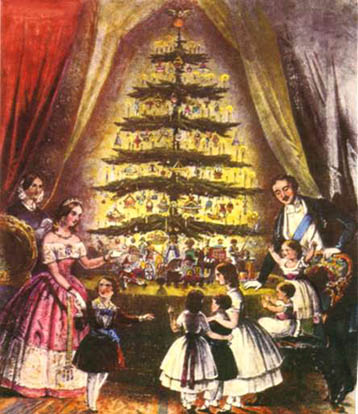The Historical Origins of
the
Christmas Tree
![]()
Compiled by Mary Stephens
Nov. 2012
Since there are secular sources who do a good job of presenting the information which I wish to give you, I will primarily quote others. Links are provided where available, but note that sometimes pages are taken down, moved or changed, so in some cases you may find the original source of my information is now gone, or a link dead.
Ancient Heritage
From www.history.com
Long before the advent of Christianity, plants and trees that remained green all year had a special meaning for people in the winter. Just as people today decorate their homes during the festive season with pine, spruce, and fir trees, ancient peoples hung evergreen boughs over their doors and windows. In many countries it was believed that evergreens would keep away witches, ghosts, evil spirits, and illness.
History of Christmas Trees
 The ancient Egyptians worshipped a god called
Ra, who had the head of a hawk and wore the sun as a blazing disk in his
crown. At the solstice, when Ra began to recover from the illness, the
Egyptians filled their homes with green palm rushes which symbolized for
them the triumph of life over death.
The ancient Egyptians worshipped a god called
Ra, who had the head of a hawk and wore the sun as a blazing disk in his
crown. At the solstice, when Ra began to recover from the illness, the
Egyptians filled their homes with green palm rushes which symbolized for
them the triumph of life over death.
Early Romans marked the solstice with a feast called the Saturnalia in honor of Saturn, the god of agriculture. The Romans knew that the solstice meant that soon farms and orchards would be green and fruitful. To mark the occasion, they decorated their homes and temples with evergreen boughs. In Northern Europe the...Druids, the priests of the ancient Celts, also decorated their temples with evergreen boughs as a symbol of everlasting life. The fierce Vikings in Scandinavia thought that evergreens were the special plant of the sun god, Balder.
Germany is credited with starting the Christmas tree tradition as we now know it in the 16th century when devout Christians brought decorated trees into their homes... History of Christmas Trees
From delongfarms.com
To fully appreciate the
history of the Christmas tree, one must understand the mystical
importance coniferous evergreens held for the pagan Norsemen who
inhabited the frigid and often enchanting forests of Northern
Germany...Pre-Christian Pagans inhabited a land that they believed they
shared with numerous Gods [sic], nature-spirits, and demons. A common example
was the Norse worship of the Oak tree; its strong and long burning wood
was a sign of the strength of the spirits that inhabited the Oak, and it
was often used as a symbol of the Norse god chieftain, Odin.
When the seasons turned, however, and winter brought with it numerous evils and malicious spirits stalking the shadows of wintery forests, the Pagan peoples would turn to the aid and magic of any nature spirits that would help them. Plants and trees such as mistletoe, holly and evergreen, unlike the forementioned [sic] Oak tree, were believed to have some special power against the darker magics [sic] of winter because they were the only plants that stayed green throughout the year. During the winter, to shore their homes from malevolent winter spirits, Pagan Germanic peoples would hang wreaths and bushels of evergreens over their doors and windows, believing their spirit was enough to ward off winter evils. In many cases evergreen decor were brought indoors where their scent could freshen the dark, medieval homes of otherwise stagnant straw and thresh. The needles and cones would even be burned as a form of incense; its smoke and fragrance filling the home with the protective spirit-magic of the evergreen.
During the
Winter Solstice, when winter was at its darkest and the days were the
shortest of the year by the Germanic Lunar Calendar, Celtic and pagan
civilizations throughout Northern Europe would celebrate and sacrifice
to the Norse god, Jul (Though pronounced and contemporarily recognized
as “Yule.”), and celebrate their Yule Tide festival. This is the
tradition from which we have our Yule log, today. [ Editor: "Yuletid"
may stil be used in more European contexts.] The Germanic practice,
however, involved cutting down a massive hardwood log that was large
enough to burn for twelve days of feasting and sacrifice, and served as
a fertility symbol to both help with the coming of spring and prophesize
[sic]
its bounty. During the Winter Solstice, when winter had its strongest
influence on the frozen landscape, Norse pagans would, by tradition,
bring entire evergreen trees into their homes. These massive evergreens
were called Yule trees, and it was believed that the spirits of the
trees would inhabit their home and bless its inhabitants. This practice
was as much Winter Solstice tradition as it was mystical protection from
night-faring spirits during the darkest times of the year.
The History of the
Christmas Tree [This is a well-researched account.]
Introduction Into Modern World and Christianity
From delongfarms.com
During the 8th Century, missionaries from
the Holy Roman Catholic Church began to make their way North to what is
now Germany and the Netherlands. One such missionary...was Boniface of
Credition. Boniface, a stalwart and moral gentile [sic], was quickly set
aback by the pagan rituals of polytheism, nature worship, and human
sacrifice. While many Germanic peoples readily accepted the Catholic
faith, there were still some hardened tribes that even proved violently
hostile in their resistance to Catholic missionaries such as Boniface.
It would be in a single legendary act that Saint Boniface of Credition
seemed to symbolically set the tone for the Holy Roman Catholic Church:
instead of usurping the pagan faith completely with Catholicism,
Boniface chose to shift their focus and also adopted the more desirable
pagan beliefs and customs himself.
It is said that when Saint Boniface came across a human sacrifice at the foot of the Oak of Thor in Geismar, Boniface cut down the oak in a symbolic act of removing the older barbaric Celtic traditions. Pointing to an evergreen that was growing at the roots of the fallen oak, Saint Boniface said, “This humble tree's wood is used to build your homes: let Christ be at the centre of your households. Its leaves remain evergreen in the darkest days: let Christ be your constant light. Its boughs reach out to embrace and its top points to heaven: let Christ be your comfort and guide.” In much the same way that the Holy Roman Catholic Church assimilated many other pagan customs and traditions to help with the converting of the Northern Germanic peoples, Saint Boniface accommodated the pre-existing Celtic beliefs in the mysticism of evergreens and incorporated it to help with a smoother transition for pagan peoples over to Catholicism. [Editor: In other words, Bonafice incorporated the less offensive pagan beliefs into Catholicism to make it more acceptable to the heathen people.]
In many ways, this legend of Saint Boniface of Credition would have helped with the incorporation of the Yule trees and Yule Tide evergreens of the Germanic Winter Solstice into the Roman's “Christ's Mass” celebrating the birth of their savior, Jesus. The converted Germans who were celebrating Christ's Mass would have celebrated in much the same way as they did the Winter Solstice, save for many of their central traditions being more gentile [sic]. The evergreen trees that they brought indoors were now symbols of the holy trinity; the stars at the top serving as a symbol of heaven and God. Apples were hung from the branches that would later become Christmas decorations, symbolizing the fruit of the tree of knowledge in the Garden of Eden... The History of the Christmas Tree
![]()
Links:
(Disclaimer on some content and Bible
versions other than the KJV.)
A short secular video on the origins of Christmas trees.
![]()
vintage graphics: unknown
updated 2023


